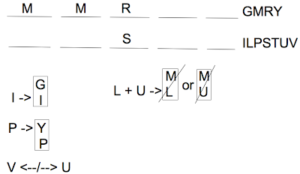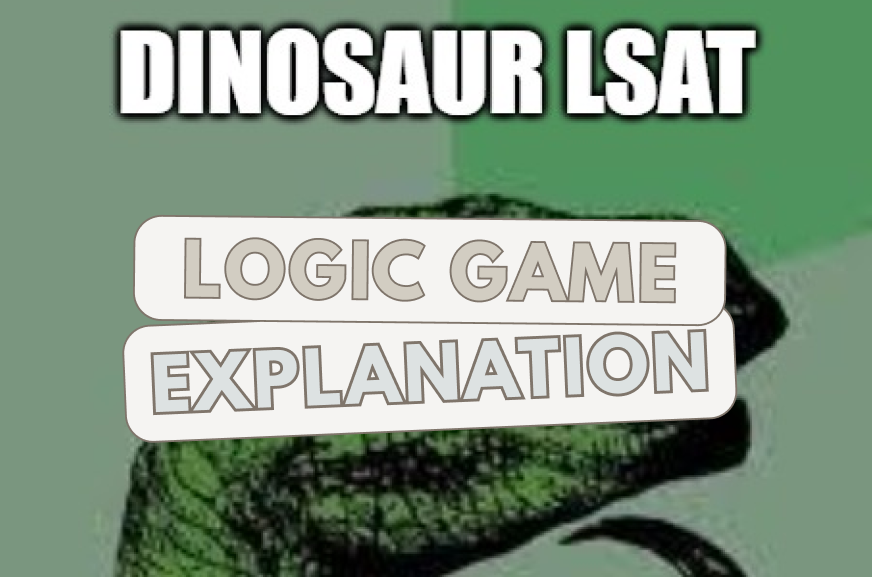I would categorize this game as a combination of Selection (In-Out) and Matching.
Basically, we’re selecting some variables but not others, and we’re associating variables of different types with each other. There’s no sequencing or linear aspect to this game.
Due to copyright restrictions, I’m forced to leave out the text of the game. You’ll need a copy of LSAT PrepTest 57 (the June 2009 LSAT) in order to follow along.
Setup and Main Diagram
We’re picking 5 out of 7 dinosaurs. Each dinosaur is one of 4 colors.
7 Dinosaurs: Iguanadon, Lambeosaur, Plateosaur, Stegosaur, Tyrannosaur, Ultrasaur, Velociraptor
4 Colors: Green, Mauve, Red, Yellow
_ _ _ _ _ GMRY (colors)
_ _ _ _ _ ILPSTUV (dinos)
We have definitely have 2 mauves (I didn’t know it was a color either).
We also definitely have RS (red stegosaurus – with R above S as a vertical block).
so we can put down:
MMR_ _ = GMRY
_ _ S_ _ = ILPSTUV
Next: I only if G. “Only if” introduces the necessary condition, so we can say “if I -> GI.” Because we only care about I’s color if it’s selected, we can say GI and put it on the side (G above I as a vertical “block”)
Same goes for if P -> YP (Y above P as a vertical “block”)
V only if U is not = If V-> not U (or U)
Contrapositive: If U -> not V (or V)
This means U and V are never together = V <–/–> U (V double-not arrow U).
If L and U -> ML doesn’t happen (ML) or MU doesn’t happen (MU). (Again, these should be vertical with M above L and M above U, respectively).
What we have so far should look something like the following picture:

Inferences and Limited Options / Templates / Possibilities:
Let’s take the knowledge that S has to be R, I has to be G, and P has to be Y (if they go, that is).
Indirectly, this is telling us that out of the 7 dinosaurs (ILPSTUV), only L, T, U, and V could ever be M.
However, we know we’ll never have both U and V being M. This is because we can never have them both “in” (see the double-not arrow above).
Additionally, we can’t have both L and U being M.
The possible combinations of Mauve dinosaurs are, as a result, pretty limited:
LT
LV
TU
TV
We can draw 4 templates using this information. However, we really only need 3, because TU and TV are virtually the same thing. T isn’t involved in any other rules, so when T is Mauve and we have one of U/V, U and V are interchangeable – one is in, but the other is out.
This means we can represent the Mauve pairings as really being only possible 3 combinations:
L T
L V
T U/V
Placed on the diagram…
with LT as the Mauve pair:

with LV as the Mauve pair:

with T and one of U/V as the Mauve pair:

This pretty much breaks the game wide open. In each of these templates, the dinosaurs that can be in the remaining two spots are pretty limited.
Below, I’ve placed the pool of 3 “maybes” in parentheses. Each valid scenario would include any 2 out of those 3.
Template #1:
The “LT Mauve pair” template:

Template #2:
The “LV Mauve pair” template:

Template #3:
The “T and one of U/V Mauve pair” template:

These templates address the V <–/–> U rule and the “LU can’t both be Mauve” rule. All we need to keep in mind now when using the templates is that if I is chosen, it will be G, and if P is chosen, it will be Y.
Question 12
Typical question asking which one could be a valid scenario. However, it refers only to dinosaurs and doesn’t concern colors, so the templates aren’t a huge help here.
Just pick one rule at a time and apply it to the choices.
We always need to have S, so we can eliminate D.
We can’t ever have both V and U, so A and E are out.
Choice C lists ILPSU. The problem with this choice is that I, P, and S already have colors associated with them (G, Y, and R, respectively). This would force L and U to both have mauve, which can’t happen according to our rules. For this reason, C is out, and B is our answer.
Question 13
If T is out, then we’re definitely not going to use the LT or T U/V templates.
We’re going to use the LV template, and we’re not going to pick T from the parentheses, giving us:

Because the diagram is fully determined, all you have to do now is scan the choices to see which does not appear. Whatever doesn’t appear will be your answer. In this case, it’s D.
Question 14
Sadly, question 13’s diagram doesn’t help at all because it doesn’t contain GL or YT.
Go back to the templates. GL could never occur in the first 2 templates because L is always M in those templates. However, we could have GL in the third template. In that template, T has to be M, so A works.
Question 15
In the 1st and 3rd templates, T has to be M. However, in the 2nd, it could be Y, so we must be dealing with the 2nd template.
We’ve never had YT before, so it’s time to draw a new diagram:
MMRY_
L V ST_
This leaves GI or YP.
The diagram should look something like the following:

We don’t know whether we’ll have GI or YP on the 5th pair of slots, but it doesn’t matter. MV has to happen, so choice E is the answer.
Question 16
We’ve never had both I and U before, so we’ll need a new diagram.
We don’t know whether we’re dealing the 1st template or the 3rd, but we know that we’re definitely not dealing with the 2nd.
Even without drawing them out specifically to include I and U, we can see that both templates have MT because Templates 1 and 3 are LT and T U/V, respectively. They both include an MT. Making A our answer.
However, for those of you who want to see what I and U being “in” looks like, here it is:
In Template 1, including both I and U would give us


There obviously isn’t room to have both P and L, so we’ll have one or the other. If we have P, it’ll be Y, but if we have L, we don’t know what color it’ll specifically be. Again, depending on your preference, you could put G/R/Y to the right of the big slash and box it with L, or you could just leave it empty as I did above.
It doesn’t really matter anyway, though, because the question is asking us what must be true across both templates. Both have MT.
Question 17
If we have 2 Gs, what could be true? Well, the bad news is that we could be dealing with any of the 3 templates.
The good news, though, is that we’re definitely not going to have P, so each of the three templates is either fully determined or almost fully determined.
Template #1:

Template #2:

Template #3:
![]()
In Template #2, it’s possible to have a green tyrannosaurus, so B is our answer.
***
Is this a tough game? Absolutely. But is it doable? Yes.
It’s not an 8-minute 45-second game for most people. However, the other games in the section (the first one, in particular) are easier in order to balance things out.
Seeing this game explained should ensure Jurassic Park won’t give you any more nightmares.

